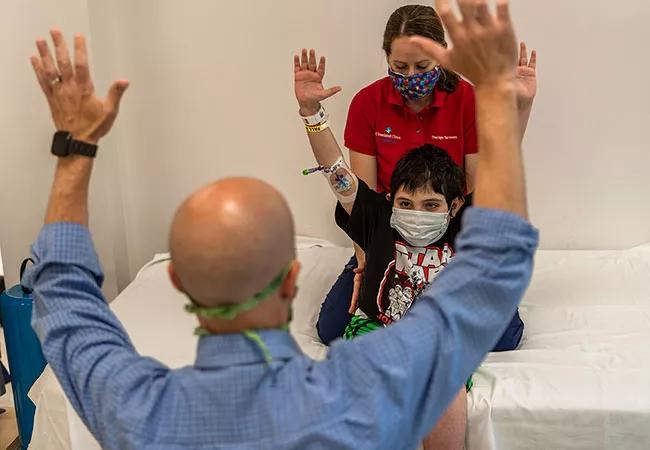Pilot initiative focuses on adolescents with disabilities

The process of transitioning adolescents and young adults from pediatric to adult care can seem bewildering to patients, families and even healthcare professionals. The handoff becomes more challenging for patients with physical or intellectual disabilities.
Advertisement
Cleveland Clinic is a non-profit academic medical center. Advertising on our site helps support our mission. We do not endorse non-Cleveland Clinic products or services. Policy
“Oftentimes, patients who require ongoing management of chronic conditions aren’t sure how to find a provider who best fits their needs or how to navigate the healthcare system in general. There’s even another layer to that for people with disabilities,” says Francois Bethoux, MD, Chair of Cleveland Clinic’s Department of Adult Physical Medicine and Rehabilitation (PM&R). “They need to know their needs will be met, from providers aware of their special requirements to accessible facilities.”
Cleveland Clinic’s Departments of Pediatric and Adult PM&R recently launched a program for adolescents with disabilities to help facilitate a smooth transition from pediatric to adult rehabilitation care. The need for such a program is well-documented: Only 22.5% of U.S. youths aged 12 through 17 with special healthcare needs received the necessary services to transition to adult care in 2019 and 2020, according to the National Survey of Children’s Health.
The PM&R program is one of eight pilot programs in a pediatric-to-adult care transition initiative at Cleveland Clinic that uses resources from Got Transition®, a federally funded national resource center on healthcare transition.
The Departments of PM&R started working together on this transition-of-care plan just as the COVID-19 pandemic began. The team initially sought to run a joint in-person transition clinic between pediatric and adult providers, but the pandemic and scheduling challenges led to the adoption of a virtual visit format.
Advertisement
During the planning stages, Dr. Bethoux and Lainie Holman, MD, Chair of Pediatric PM&R at Cleveland Clinic Children’s Hospital for Rehabilitation, formed a group of physiatrists, nurses, social workers, and physical, occupational and speech therapists to develop the rehabilitation pilot. Like Cleveland Clinic’s other care transition pilot programs, this one uses the Six Core Elements™ from Got Transition as its base: transition and care policy/guide, tracking and monitoring, transition readiness, transition planning, transfer of care and transfer completion. However, the team recognized that patients with disabilities have additional needs.
“We realized that we needed to adapt the Six Core Elements to our specific patient population and issues distinct to their care,” says Dr. Holman. To address the special needs of patients with disabilities, the group considered the following:
Advertisement
The team has identified patients for the transition process and has created a shared patient list in the electronic medical record (EMR). A medical summary document with a comprehensive functional history (gross and fine motor function, cognition/education, communication needs, vocation/avocations and equipment requirements) has been created specifically for this purpose. The EMR also includes readiness assessment questionnaires used by all Cleveland Clinic pediatric-to-adult transition pilot programs.
A couple of rehabilitation patients with disabilities have completed all six steps and successfully transitioned to adult care. Several others are candidates for the pilot’s virtual “warm handoff,” where pediatric providers will be present in person with the patient and family and the adult-care physiatrist and other team members will participate via secure video.
“This interaction provides children and families the ability to meet their future care team in a familiar environment and see that their needs are communicated from the previous team in real time, with the opportunity for questions and clarifications,” says Dr. Holman, who recently presented a poster on this rehab transition-care pilot at the 2021 annual meeting of the American Academy for Cerebral Palsy and Developmental Medicine.
When fully implemented, the care transition process will begin when patients with disabilities — primarily neurodevelopmental disorders — are 14 to 16 years old. Along the way, providers will assess patients’ readiness to transition and address any concerns about independently managing care before the transition occurs.
Advertisement
“When the transition time approaches, there will be an introduction to at least one adult rehab provider who will be the quarterback for the patient’s adult care and ensure they get referred to other specialists too,” says Dr. Bethoux.
“We hope to grow our network so that additional providers build expertise in the types of needs our patients have and will become a natural destination for referrals,” he adds. “Many providers may not have been exposed to some of the disabilities we routinely see, and they may not know where to turn to get rehab specialists for their patients. This clinic for pediatric-to-adult rehabilitation care transition will be a service not just to patients and their families, but to providers as well.”
Advertisement
Advertisement

Large NIH-funded investigation is exploring this understudied phenomenon

Advances in genomics, spinal fluid analysis, wearable-based patient monitoring and more

Case study of radial-to-axillary nerve transfer for tumor-related deltoid nerve injury

An update on the technology from the busiest Gamma Knife center in the Americas

Real-time adjustments may help reduce bothersome dyskinesias

Anatomical modeling can identify optimal surgical candidates, study suggests

Add AI to the list of tools expected to advance care for pain patients

New guidelines from Brain Trauma Foundation urge early and aggressive treatment